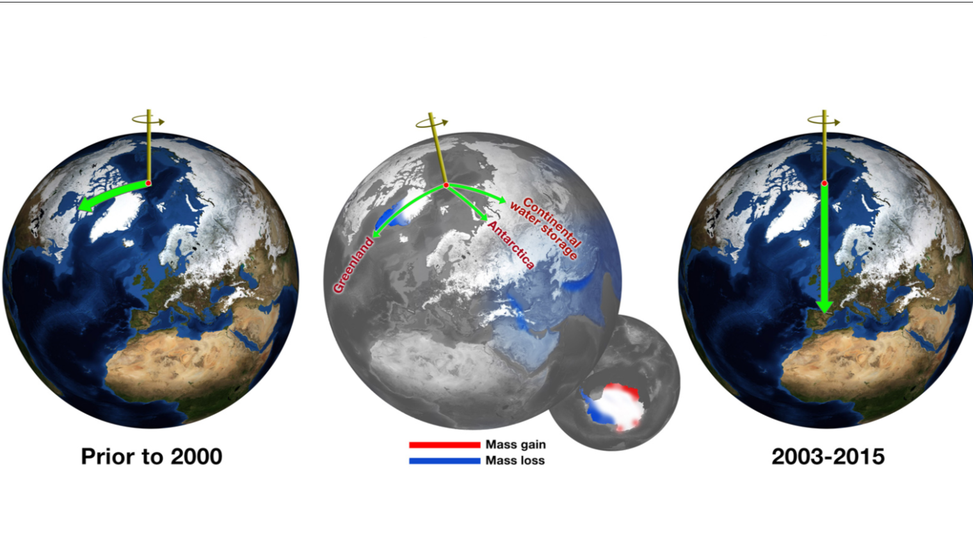Climate 101 is a Mashable series that answers provoking and salient questions about Earth’s warming climate.
Greenland is purging ice into the ocean.
And Earth noticed.
A strange impact of the continuously warming climate is that colossal amounts of ice melting into the planet’s oceans have played a prominent role in moving Earth’s axis — the invisible line Earth rotates around. As the planet warms, ice from glaciers and ice sheets migrates from land into the sea (as water), which majorly redistributes weight on the globe. This phenomenon, which scientists recently found more evidence for, ultimately shifts the planet’s axis, something scientists call “polar drift.”
“The Earth is like a spinning top, and if you put more mass on one side or the other, the axis of rotation is going to shift slightly,” explained Isabella Velicogna, a professor of earth system sciences at the University of California, Irvine, and a researcher at NASA’s Jet Propulsion Laboratory.
(There’s no need to panic: The slight nudge, while a change to Earth’s axis, won’t impact life on the planet, though the melting ice has the added deleterious effect of driving significant sea level rise. It’s normal for Earth’s axis to drift around, and the shifts are small compared to the size of the planet. For example, the axis only drifted some four inches a year during the 20th century.)
In 2016, NASA researchers used satellite observations to show that major ice loss (particularly from Greenland) played a significant role in nudging Earth’s axis eastward, starting around 2000. (The below illustration shows the phenomenon.) In the new research, recently published in the journal Geophysical Research Letters, scientists found Earth’s axis started its eastward swing (away from the south) a little earlier, in the 1990s.
“The faster ice melting under global warming was the most likely cause of the directional change of the polar drift in the 1990s,” Shanshan Deng, a researcher at the Chinese Academy of Sciences and an author of the new study, said in a statement.

A graphic showing Earth’s axis’ eastward shift after around 2000.
Image: nasa / Jpl / caltech

A graphic of NASA’s GRACE satellites, which measure mass from Earth’s ice sheets, flying over Greenland.
Image: nasa / Jpl
This latest research adds more compelling evidence to climate change’s role in moving Earth’s axis. “This study confirms previous studies that have shown the contribution of the melting of the Greenland ice sheets to the shift of Earth’s rotation axis,” said UC Irvine’s Velicogna, who was not involved in the new research. “It shows once again another impact of the melting of ice sheets on the earth system.”
Water is profoundly heavy. A cubic meter of water, around the size of a washing machine, weighs one tonne (a little more than a U.S. ton). Today, Greenland, which is driving a significant amount of axis shift, is losing some 268 billion metric tons (also called a “gigaton”) of ice into the ocean each year.
That’s a lot of redistributed weight. “We’re melting so much that it can have an effect on the axis,” emphasized Velicogna.
Though Greenland and other melting glaciers and ice sheets are now increasingly important players in moving Earth’s axis, other factors are still at play, too. Earth scientists know that slowly circulating rock deep inside the planet’s mantle shifts mass around the planet (exactly how much is still uncertain and an active area of research). So do the great masses of water naturally stored underground (and also pumped out by humans), along with land “rebounding” back up after tremendously heavy glaciers melt away.
In the coming years, decades, and beyond, climate scientists expect Earth to continue warming as heat-trapping carbon levels in the atmosphere rise. That will inevitably result in more prodigious melting from Greenland and other glaciers. This doesn’t just mean freshly redistributed water will further influence Earth’s axis. It also portends accelerated sea level rise. “The melting of the ice sheets and the glaciers and ice caps has been larger year after year in recent decades and its contribution to rising sea level will affect highly populated coastal regions around the planet,” said Velicogna. (Sea levels have risen by some eight to nine inches since the late 1800s, and a conservative United Nations estimate is sea levels will rise by another one to two feet by the century’s end. In actuality, this could be more like two or three feet, or even more.)
But that’s not all. When glaciated lands melt they lose mass and, consequently, some of their gravitational pull. This means ocean water is then tugged towards other places, ultimately resulting in even more sea level rise in regions far from areas like Greenland or Antarctica. “There’s definitely global winners and losers due to these changes,” explained Matthew Hoffman, a glaciologist and computer scientist at Los Alamos National Laboratory who had no role in the new research. “Some cities will be hit harder if West Antarctica collapses relative to other cities,” he said, referencing the accelerated melting and potential collapse of colossal Antarctic glaciers. Cities along the eastern U.S. coastline are some of these vulnerable places.

Sea level rise since 1900.
Image: nasa
[embedded content]
Earth’s axis isn’t just influenced by the happenings on the planet. Over the course of thousands of years, the sun and other objects in our solar system can cause Earth to wobble (called Milankovitch Cycles), and result in major climatic changes (like a significantly hotter northern or southern hemisphere). But today, changes to Earth’s axis are largely due to great masses of melting ice.
“It sounds fantastical,” said Hoffman. But, he noted, it’s real.
